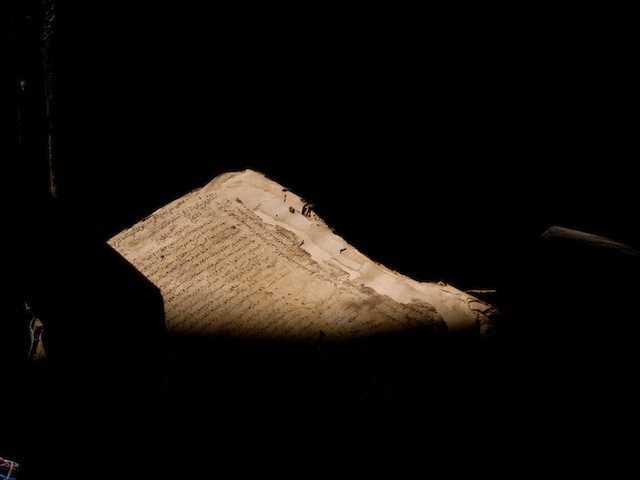The program for the 10th edition of the Bamako Encounters – African Biennale of Photography, was presented on July 11, 2015, at Arles.

Les manuscrits de Tombouctou © Seydou Camara
The presentation of the program for the 10th edition of the Bamako Encounters – African Biennale of Photography, was held on July 11, 2015, in the Cour Fanton at Arles. The speakers were Anne Tallineau, deputy general director of the Institut Français, Samuel Sidibé, general representative of the Encounters, and Yves Chatap, associate curator.
Telling Time
The last edition of this event devoted to photography and video was held in 2011. Since then there was complete silence on the future of the event due to the political situation in Mali. Although calm is apparently being maintained at the moment, at least in the capital of Mali, there was still a tangible sense of anxiety at the meeting. The organizers were keen to reassure the public who attended, and stressed the importance of resuming the Encounters. In fact, holding such events on a regular basis has proved one of the best ways to maintain stability during the kind of bad moments that have also occurred elsewhere on the continent at times. We are thinking of the experience of the biennales in Johannesburg (1997) and Benin (2012), which were suspended after their second editions. What is more, it seems clear that for the French and Malian political authorities – that coordinated the Biennale – keeping on with the Bamako venture is the best way to express the will to resist in the face of the threat from religious extremists. This latest Biennale, like its forerunners, is the result of cooperation between the Institut Français, through its developing African and Caribbean program, and the Ministry of Culture, Handicrafts and Tourism in Mali. However, certain changes were evident in the organization of the show. The most obvious change is the nomination of an English-speaking artistic director, the Nigerian Bisi Silva. On this occasion she is supported by two associate commissioners, Antawan I. Byrd and Yves Chatap. This anniversary edition has the title Telling Time, which can also mean the time to speak, or to narrate. The theme actually reflects the idea of time past, and underlines the organizers’ desire to refer back to and review the two previous editions. The issue of narrative underpins the theme as well. No opportunity was available to discuss the present period or the Biennale. To quote the Encounters press release: “This edition will provide space for a retrospective of the previous editions… […] The photographers will be invited to tell the story of Africa not through a superficial vision of things but by attempting to use images to plumb the depths of reality of our times.”
The Program
The number of exhibition spaces in the Biennale is somewhat reduced. The Pan-African display curated by Bisi Silva will be presented at the National Museum of Mali. The works of 26 photographers and 13 video artists will be on show there. The local museum and memorial for the revered Malian president Modibo Keïta will be the sites of solo shows of emblematic artists, J.D. Okhai Ojeikere (1930-2014), William Kentridge (South Africa), Ayrson Heraclito (Brazil), and Hrair Sarkassian (Armenia). The exhibition spaces include thematic displays on representation of the body in photography based on the title figure in Oscar Wilde’s novel, The Picture of Dorian Gray. Yves Chatap is the curator for these shows. The premises of the Institut Français in Bamako will house the exhibition “Koudjina en héritages.” This project, by photographer Philippe Guionie, is an homage to the photographer of nightlife in the Nigerian capital, Philippe Koudjina (1939-2014). Finally, the event organizers carefully reconsidered the issue of the Mali public’s access to the Biennale. As a result they commissioned various special projects in addition to the educational programs of the previous two Biennales. In this context we can already mention: “1384 Days Wide,” a participatory project to be shown in the park of the National Museum of Mali, consisting of photographs taken between January 16 and October 30, 2012 displayed in chronological order. The goal is to use the image to give an account of the lives of Malians during that troubled period in the country. On a different note, the project “Studio Mali” will invite the photo studios in the city of Bamako to exhibit their archives in the neighborhood quarters. The regular round table discussions and portfolio reviews will be held, as usual, during the week for professionals. In conclusion, we know there will be a fringe program but there is little information available on this as yet.
Based in Paris, Dagara Dakin graduated in art history and is a freelance author, critic and exhibition curator.
More Editorial